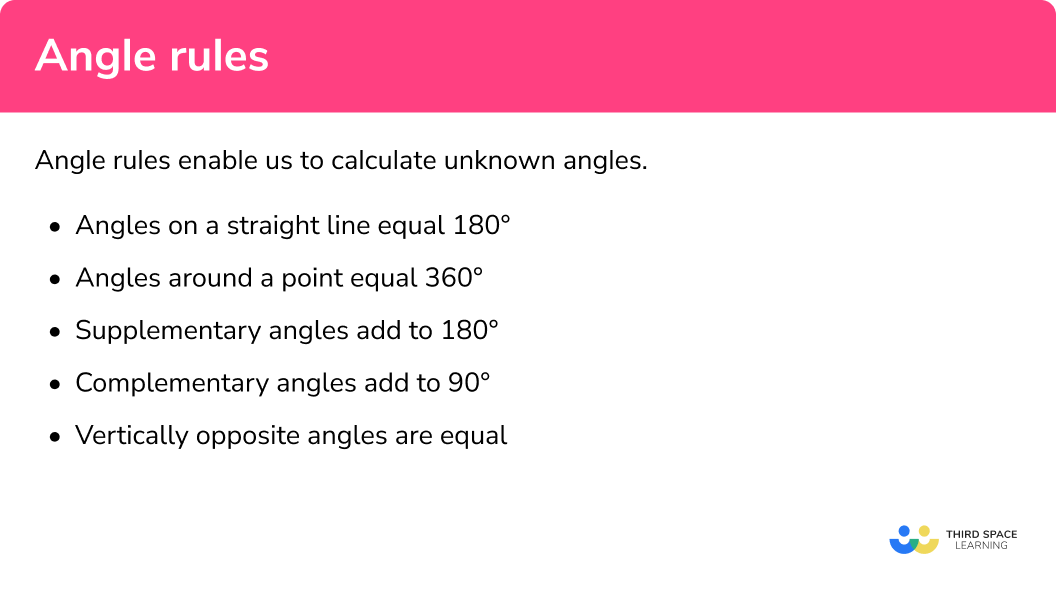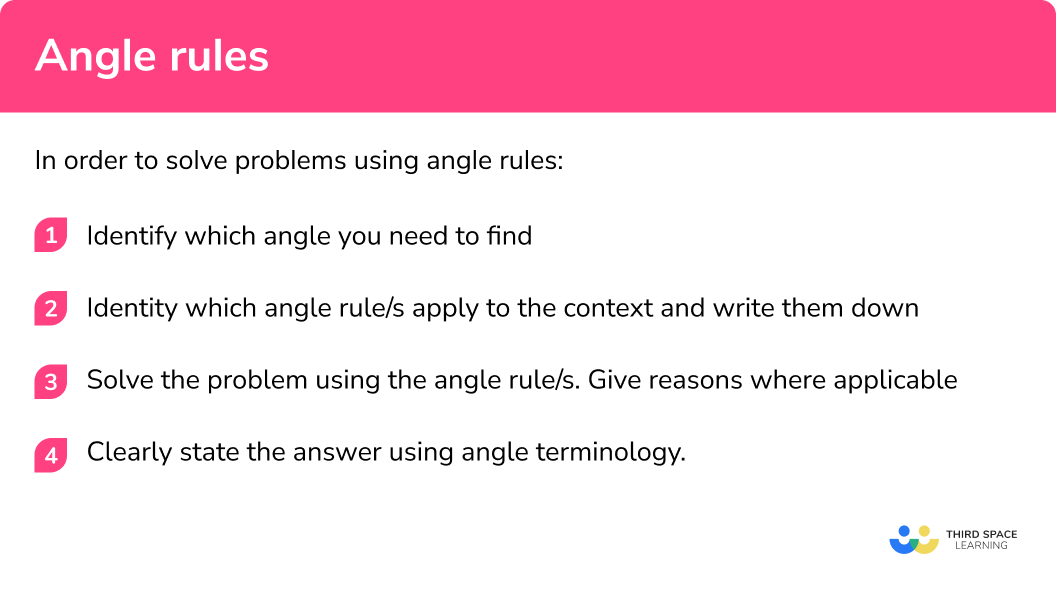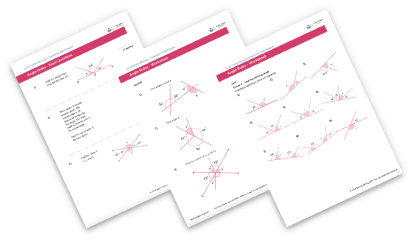how to find what x equals when a complemary nagle have an expoenet
Bending Rules
Here we will acquire about bending rules including how to solve problems involving angles on a directly line, angles around a point, vertically opposite angles, complementary angles and supplementary angles.
There are too angle rules worksheets based on Edexcel, AQA and OCR exam questions, along with further guidance on where to go adjacent if yous're still stuck.
What are angle rules?
Angle rules enable us to calculate unknown angles:
- Angles on a straight line equal 180 º
Angles on a directly line ever add up to 180º.
E.g.
Here the 2 angles are labelled 30º and 150º . When added together they equal 180º and therefore lie on a straight prevarication. These angles share a vertex.
However, beneath we can come across an example of where two angles do non equal 180º:
This is because they do not share a vertex and therefore do not lie on the same line segment.
Note: y'all can try out the above dominion past drawing out the above diagrams and measuring the angles using a protractor.
Step-by-step guide: Angles on a straight line
- Angles around a point equal 360 o
Angles around a point will e'er equal 360º.
E.g.
The three angles above share a vertex and, when added together equal 360o.
Step-by-step guide: Angles effectually a betoken
- Supplementary angles
2 angles are supplementary when they add up to 180º , they practice non have to exist next to each other.
E.g.
These two angles are supplementary because when added together they equal 180º.
Step-by-step guide: Supplementary angles
- Complementary angles
Two angles are complementary when they add upwardly to 90º , they practice not accept to be next to each other.
E.1000.
These two angles are supplementary because when added together they equal 90º.
Footstep-by-step guide: Complementary angles
- Vertically reverse angles
Vertically opposite angles refer to angles that are contrary one another at a specific vertex and are created by two lines crossing.
Eastward.k.
Hither the two angles labelled '
The same applies to angles labelled as '
Step-by-step guide: Vertically contrary angles
When solving issues involving angles sometimes we utilize more the above rules. Below you will run across a range of problems involving angles with links to lessons that will become into more item with more complex questions.
What are bending rules?

Keywords
It is important we are familiar with some central words, terminology and symbols for this topic:
- Bending : defined as the amount of turn round a common vertex.
- Vertex : the point created past two line segments (plural is vertices).
We normally label angles in ii main ways:
aneBy giving the angle a 'proper name' which is normally a lower case letter such equally
2By referring to the angle equally the three letters that define the bending. The center letter refers to the vertex at which the angle is e.m. come across below for the bending we phone call
How to use angle rules
In order to solve problems involving angles you should follow these steps:
- Identify which bending you need to discover.
- Identity which bending rule/southward apply to the context and write them downwardly.
- Solve the trouble using the above bending rule/southward. Requite reasons where applicative.
- Clearly state the reply using angle terminology.
How to use angle rules


Angle rules worksheet

Get your gratis Angle Rules worksheet of 20+ questions and answers. Includes reasoning and practical questions.
DOWNLOAD FREE

Angle rules worksheet

Get your complimentary Angle Rules worksheet of xx+ questions and answers. Includes reasoning and practical questions.
DOWNLOAD FREE
Angle rules examples
Example 1: angles on a straight line
Find anglesa andb.
- Identify which bending you need to find (label it if you lot need to).
You need to find angles labelled a and b.
2Identify which angle rule/due south apply to the context and write them down (call back multiple rules may be needed).
Angles on a straight line at the aforementioned vertex always add upwardly to 180o.
Notice how angles a and b do non share a vertex.
3Solve the problem using the above angle rule/s. Give reasons where applicative.
\[\begin{aligned} a+110&=180 \\ a=&70 \finish{aligned}\]
\[\brainstorm{aligned} b+55&=180 \\ b&=125 \end{aligned}\]
4Clearly state the reply using angle terminology.
Angle
Bending
Example two: angles around a point
Find the size of θ:
Identify which angle yous demand to find (label it if you need to).
You demand to find the angle labelled θ (theta).
Identity which angle rule/southward apply to the context and write them downward (remember multiple rules may exist needed).
All the angles are effectually a unmarried vertex and we know that angles around a point equal 360o.
Solve the problem using the above bending rule/s. Requite reasons where applicable.
\[\brainstorm{aligned} \theta+120+95+xxx&=360 \\ \theta+245&=360 \\ \theta&=115 \stop{aligned}\]
Clearly country the answer using angle terminology.
\[\text{Angle } \theta = 115^{\circ}\]
Example 3: using supplementary angles
Two angles are supplementary and one of them is 127°. What is the size of the other angle?
Identify which angle y'all need to discover (label it if you demand to).
Yous need to find the other angle in a pair of supplementary angles where one is 127°. We will call this angle '
Identity which angle dominion/s apply to the context and write them down (remember multiple rules may be needed).
Supplementary angles add together upwardly to 180°.
Solve the problem using the higher up bending rule/due south. Give reasons where applicative.
\[\brainstorm{aligned} 127 +a &= 180\\ a&=53\\ \terminate{aligned}\]
Clearly state the answer using bending terminology.
The other angle is 53°.
Example 4: using complementary angles
If two angles are complementary and one of them is 34°, what is the size of the other angle?
Identify which bending you demand to notice (characterization it if you need to).
You demand to notice the other angle in a pair of supplementary angles where one is 34°. We will call this angle '
Identity which angle dominion/s utilise to the context and write them down (remember multiple rules may be needed).
Complementary angles add up to 90°.
Solve the problem using the above angle rule/s. Requite reasons where applicable.
\[\brainstorm{aligned} 34 + b &=ninety\\ b &= 56\\ \end{aligned}\]
Clearly state the answer using angle terminology.
The other bending is 56°.
Example 5: vertically opposite angles
Discover bending
Place which angle you need to notice (characterization it if you need to).
Find the bending at vertex
Identity which angle dominion/south apply to the context and write them downwards (remember multiple rules may be needed).
Angle
Vertically opposite angles are equal to one another
Solve the trouble using the above angle dominion/s. Give reasons where applicable.
Clearly state the answer using angle terminology
Angle
Example 6: Applying multiple rules to solve a trouble
In the diagram below:
- Angle AOB is a right bending.
-
AOE andEOD are complementary angles.
- Bending
AOE isl degrees.
Find bending
Identify which angle you need to find (characterization information technology if you need to).
Allow'due south offset by labelling the diagram. We take labelled the angle we are trying to find
Identity which angle dominion/s utilize to the context and write them downward (recollect multiple rules may be needed).
Two angles are complementary when they add upward to ninetyo.
Angles around a point will always equal 360o.
Angles on ane part of a direct line e'er add together up to 180o.
Vertically opposite angles are equal.
Solve the problem using the above bending rule/s. Give reasons where applicable.
Note: there are multiple means we can solve this trouble. Below is just one method.
As
\[\begin{aligned} 50+E O D&=90 \\ E O D&=40 \cease{aligned}\]
\[\begin{aligned} B O C&=E O D \\ B O C&=twoscore \terminate{aligned}\]
Angles around a bespeak are equal to 360 degrees. Therefore:
\[\begin{aligned} A O B+A O Eastward+E O D+B O C+x=360 \\ ninety+fifty+forty+40+x=360 \\ 220+10=360 \\ 10=140 \end{aligned}\]
Clearly state the answer using angle terminology.
Angle
Mutual misconceptions
- Incorrectly labelling angles
- Misuse of the 'straight line' rule where angles exercise not share a vertex
- Mixing upward the rules for supplementary and complementary angles
- Finding the incorrect bending due to misunderstanding the terminology
Practice angle rules questions




Using angle on a directly line nosotros have 180 – (xc + xxx) = 60^{\circ}


The sum of these angles is 360 .




Using angles around a bespeak, we accept 360 – (125 + 125 + 50) = 360 – 300 = threescore^{\circ}


The sum of these angles is not 180 .


The sum of these angles is ninety .




Vertically reverse angles are equal
Bending rules GCSE questions
ane. Work out the size of angle z .
(2 marks)
Show answer
360-169-83
(one)
108^{\circ}
(1)
2.
(a) Find the size of angle a .
(b) Find the size of angle b .
(iii marks)
Show answer
a)
49^{\circ}
(1)
b)
180-49
(1)
131^{\circ}
(1)
three. Piece of work out the size of angle ten . Give reasons for your respond.
(iii marks)
Testify respond
180-xc-57=33
(1)
Angles on a directly line add together upwards to 180^{\circ}.
(ane)
x=33^{\circ}
(one)
Learning checklist
Y'all have now learned how to:
- Utilize conventional terms and notation for angles
- Apply the properties of angles on a straight line, around a point and on vertically opposite angles
- Apply bending facts and properties (e.g. supplementary and complementary angles) to solve problems
Even so stuck?
Prepare your KS4 students for maths GCSEs success with Third Infinite Learning. Weekly online one to one GCSE maths revision lessons delivered past proficient maths tutors.

Find out more most our GCSE maths revision programme.
robinsonbhars1951.blogspot.com
Source: https://thirdspacelearning.com/gcse-maths/geometry-and-measure/angle-rules/
0 Response to "how to find what x equals when a complemary nagle have an expoenet"
Yorum Gönder